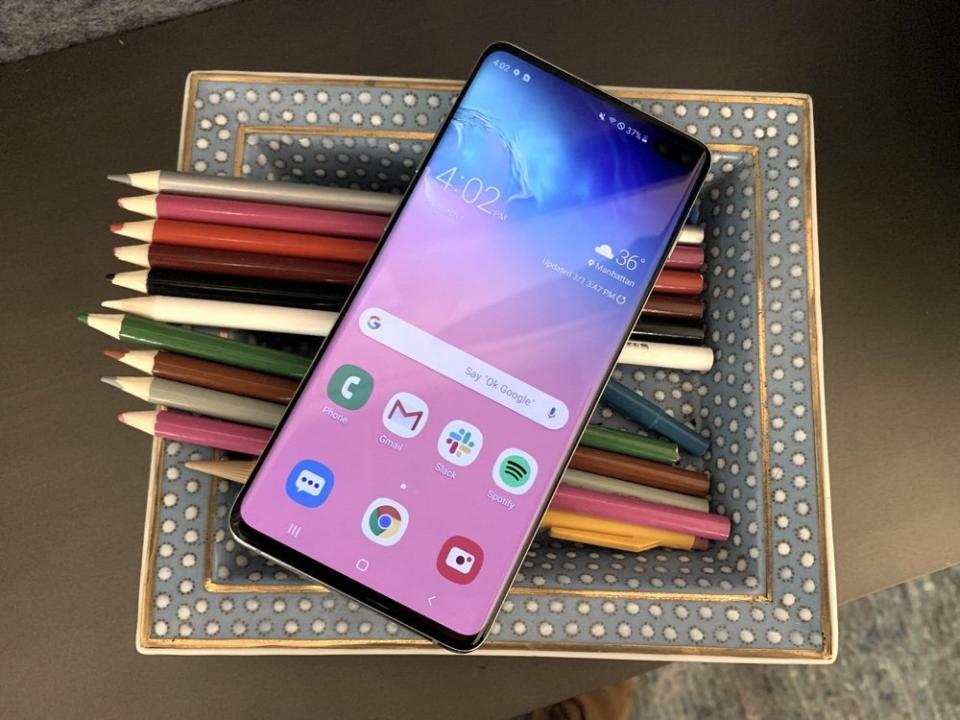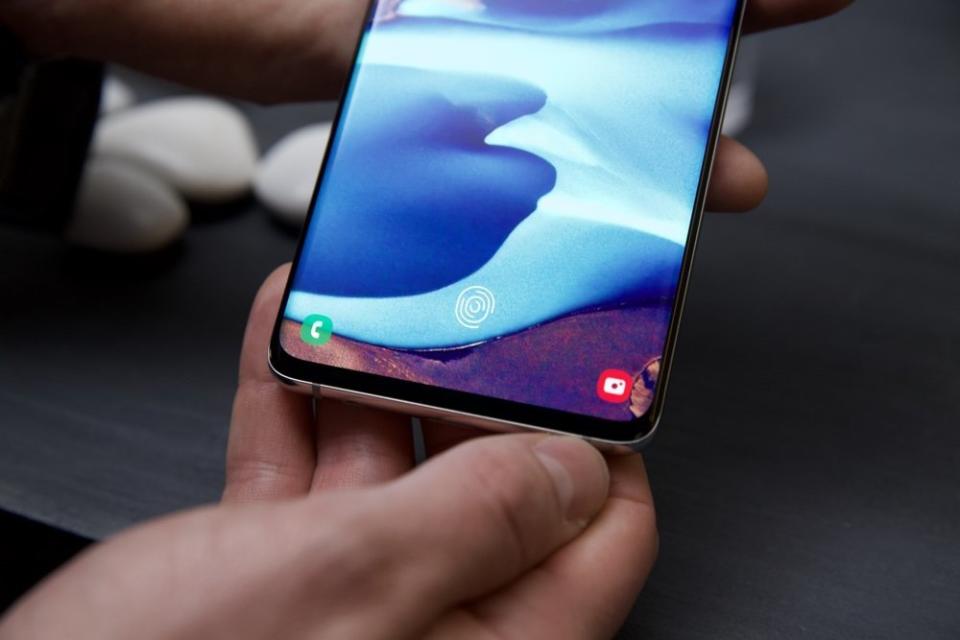Samsung Galaxy S10 Plus review: A new Android favorite
Samsung’s Galaxy S10 has landed. And after spending roughly a week with the smartphone, I’ve come away thoroughly impressed with the tweaks and improvements the tech giant has made to its flagship device.
Samsung is selling the S10 in three different variants. There’s the entry-level S10e, which starts at $749; the mainstream S10 for $899 and the premium S10 Plus for $999. A 5G version of the S10 is coming later this spring, but pricing hasn’t been announced.
I reviewed the S10 Plus, which gets all of Samsung’s latest top-of-the-line features including two front cameras, three rear cameras, a massive screen and in-display fingerprint reader. Overall, the S10 is a worthy successor to the Galaxy S line, and a handset every Android phone fan should consider.
Party in the front
The S10 and S10 Plus both sport the company’s new Infinity-O screens, with curved edges that cascade over their left and right sides. The screens have even been stretched out more vertically so that they nearly touch the phones’ top and bottom edges.
The S10e, meanwhile, has a flat display, and while the edge screens of the S10 and S10 Plus make for a unique look, I actually prefer the S10e’s aesthetic. It sounds counterintuitive, but giving the screen a defined border around its edges makes it stand out more.
With their screens taking up real estate on the front of the phones, the S10e, S10 and S10 Plus had no room for their front cameras. So Samsung cut a hole in the phones’ displays, hence the Infinity-O moniker. Thankfully, the punchouts are positioned high enough on the phone to ensure that they don’t interfere with on-screen content.
A new screen and fingerprint reader
Samsung’s new screens also use an improved panel technology the company calls Dynamic AMOLED. The change increases the brightness of the display for outdoor viewing and makes it HDR+ compatible. HDR+, of course, is Samsung’s proprietary HDR standard. Samsung says the new screens also emit less blue light, which can impact users’ sleep patterns.

Is the display a winner? Yes. This is the Samsung we’re talking about. They’ve been producing some of the best smartphone displays for years, and the S10’s panel is no different.
One thing Samsung actually removed from the S10 line was the company’s rear fingerprint reader. Positioned next to the back camera on the S9 and Note 9, the reader was difficult to distinguish from the rear camera, making it a pain to unlock your handset.
So Samsung has developed an in-screen ultrasonic fingerprint reader for the S10 and S10 Plus. The S10e gets a fingerprint reader built into its power button. To use the ultrasonic reader, you need to ensure that you place your finger over the exact part of the display for the reader to recognize your print, which takes some getting used to since there’s no physical landmark to guide your digit. An on-screen image of a fingerprint helps, but there’s nothing you can feel to ensure you’re in the right spot.

More often than not, the reader on the S10 Plus was able to detect my fingerprint, but there were a few occasions when it said my finger wasn’t a match, or that I wasn’t pressing down hard enough on the screen. Samsung said that this may be an issue with the software running on my device, which should be updated for general consumers.
More cameras, more selfies
With most of today’s smartphones offering similar features, manufacturers are increasingly turning to their devices’ cameras to help differentiate them from the competition. For Samsung, that means adding a third camera to the back of the S10 and S10 Plus and a second camera to the front of the Plus. The S10e gets two rear cameras and a single front lens.
The three rear cameras on the S10 Plus include an ultra-wide-angle lens, a standard wide-angle lens and a telephoto lens. The S10e gets a wide-angle lens and telephoto lens. What’s the point of the ultra-wide lens? Samsung says it gives you the ability to capture everything you see in each shot, rather than when you normally take a photo and can’t quite capture everything you’d like without backing up 10,000 feet.
And boy does that ultra-wide lens capture everything. Images shot with the lens have a curved look towards their edges similar to what you’d see on a standard ultra-wide-angle lens for a standalone camera.

I took a photo of Manhattan from Yahoo Finance’s 9th floor office and the difference between what I could see in the ultra-wide-angle lens versus the wide-angle lens was staggering. Even trying to capture groups of friends is easier with the added lens.

Overall, Samsung’s cameras capture excellent shots. As usual for a Samsung phone, colors pop more than on Apple’s (AAPL) iPhone and Google’s (GOOG, GOOGL) Pixel 3. The greens and reds of a lettuce wrap sandwich were more livelier when captured with the S10 than the Pixel 3 or iPhone XS Max, which focuses more on realistic coloring.
The S10 performed surprisingly well in low-light situations, too. Apple’s iPhone struggled without the flash when taking pictures at a bar, but the S10 pulled off some well lit shots without making them appear grainy.

The Pixel 3’s standard shooting mode made low-light photos look muddy, but when I switched to the handset’s Night Sight feature, my shots came out incredibly bright. It’s still the best way to take low-light photos, but you also have to stay very still to get a decent image.

Up front, the S10 has two front cameras that allow for you to take shots with a bokeh effect. The secondary camera, allows the phone to capture depth-of-field ensuring that things like stray pieces of hair and other fine details remain in focus. You can also zoom out with the selfie cameras to fit more people into your shot.
Streamlined performance
Samsung has loaded the S10 with its new Android-powered One UI interface, which succeeds in making the handset easier to navigate using one hand. App controls have been moved to the lower half of the screen to make them easy to reach with your thumb, and the software’s overall look has been overhauled to be cleaner and clearer.
My one issue with the interface is that it bombards you with notifications during setup to get you to enable or disable certain features. I appreciate the option to use the settings I want, but Apple makes setting up its iPhone far easier.
As for performance, all of the phones in the S10 line get Qualcomm’s (QCOM) latest Snapdragon 855 processor. The base S10e comes with 6GB of RAM and your choice of 128GB or 256GB of storage. The S10, on the other hand, gets 8GB of RAM and either 128GB or 512GB of space. Then there’s the S10 Plus, which also gets 8GB of RAM in its 128GB and 512GB versions, but jumps to 12GB of RAM if you opt for the 1TB of storage. Needless to say the S10 is a freakishly fast smartphone.
Battery life is equally impressive. I kept the S10 Plus running for well more than a day with a single charge. And thanks to its two-way wireless charging, you can use the S10 to charge your other devices like, say, an iPhone.
Should you buy it?
The S10 Plus is a heck of an Android-powered smartphone. It’s sleek, has a beautiful new display and truly fantastic camera when shooting in most lighting situations. That ultra-wide-angle lens can’t be beat, either. I’m a fan of the in-display fingerprint reader, but wish it was more consistent.
In short, Android fans have a new favorite smartphone on their hands. But don’t expect it to convert many iPhone-lovers.
More from Dan:
Netflix subscriber survey reveals an opportunity for price hikes
How much you’ll pay for major streaming services if you ditch cable
Samsung’s $1,980 smartphone will test the limits of what consumers will pay
Email Daniel Howley at dhowley@oath.com; follow him on Twitter at @DanielHowley. Follow Yahoo Finance on Facebook, Twitter, Instagram, and LinkedIn.finance.yahoo.com/

 Yahoo Finance
Yahoo Finance 

